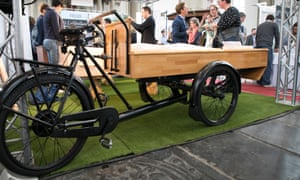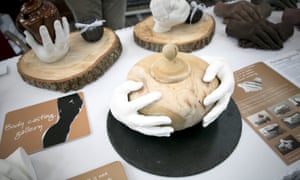The grass may be greener on the other side – but is death?
Growing numbers of people who spend their lives recycling their plastics and watching their air miles are wondering about the most environmentally sound way to deal with their mortal remains. Now, help is at hand from a funeral industry increasingly tuned in to the varied and exotic last wishes of the “consumer”.
At a packed funeral expo in a church in Amsterdam last weekend, exhibitors included a flat-pack coffin that you construct and decorate yourself which has just won the first Dutch “final footprint award” with its designs for a “CO2-neutral” casket.

“Environmental awareness needs to extend to everything we do,” says Cor Geijtenbeek, co-owner of the design firm Coffin in a Box Company. “We separate our plastics. We think about the car we drive. We also need to think about the choice of our last journey.”
Death is a growth business. More than 100 people die every minute on – 56 million in 2015 according to the World Health Organization, which predicts a 25% increase to 70 million in 2030.
Geijtenbeek reckons burial is better for the environment than cremation. But in the UK, even though three-quarters of people choose cremation, space in graveyards is running out, with almost half of local authorities expecting their cemeteries to be full by 2033.
The Dutch answer has been to allow graves to be reused, with old bones buried much deeper when a new coffin arrives for interment. This presents a problem: many modern coffins are not so biodegradable.
“In the past, people used wooden coffins made only of wood, sometimes containing cloth, but now it’s only chemically treated wood products, with synthetic glues in the casket and often paint and varnish for a high-shine effect,” says Geijtenbeek. “In no way are these coffins biodegradable and they are often made in China or eastern Europe and transported.”
He added that sometimes when a grave is cleared and the bones buried deeper to make space for the next occupant, these synthetic coffins are completely intact while the bodies have decomposed.
“Cremation isn’t necessarily better for the environment as it uses a lot of energy and raises the carbon footprint,” he adds. “Simple burial with biodegradable products is better for the environment.”
And so his firm, which already produces the low-carbon flat-pack poplar coffin, is now working in conjunction with the company Ecor on a model with sides made from recycled cellulose fibres.
He has sold a couple of hundred of his initial poplar wood model, sent through the post and costing €289 (£250) or £299 to people in Belgium, the Netherlands, the UK and Switzerland – estimating that the CO2 footprint of each is 4kg, compared with 25-30kg for a standard coffin.

He wasn’t alone at the Dutch fair. As well as a controversial “Sarco” euthanasia coffin, FAIR coffins was also offering eco-friendly shrouds, partly recycled and biodegradable coffins, made by people with disabilities – while across the world you can find coffins made from Hainsworth’s wool, willow and cardboard.
These kinds of biodegradable coffin are preferred by “green cemeteries” and Prof Douglas Davies, director of Durham University’s Centre for Death and Life Studies and author of dozens of books and studies, points out that more and more people are interested in a “wet” forest burial over a “dusty” graveyard. “There are as many natural burial sites in the UK as crematoria,” he said. “A woodland burial is somewhere dynamic, associated with life, activity, and hope.”
He adds that eco-friendliness has taken on the same kind of positive associations as the pioneering “hygienic” cremations first proposed in late 19th century: now, the UK has 281 crematoria, according to the Cremation Society of Great Britain, and more than 270 natural burial sites. In Davies’s view, the proliferation of small ventures offering alternatives from banana-leaf caskets to having your ashes scattered in space, and word-of-mouth recommendations via social media are completely changing our funerals.

At the Dutch funeral conference, a greener coffin was definitely appealing to Mieke van der Ploeg, 66, an undertaker from Den Dolder. “More and more people want eco-friendly coffins; my husband manages a natural cemetery with about 150 spaces and he wants only eco-friendly caskets,” she said.
For the consumer, the very Ikea-style process of building and decorating a coffin has emotional benefits, according to Paula Kemper, who used one to cremate her 95-year-old mother. “We ordered this coffin, put it together with my husband, and we made a very nice painting of the tree of life. My mother had seven children and more than 30 grandchildren and great grandchildren, so the children all made a flower for a branch. It helps you in your grief to do something.”
Kate Dyer and Kate Tym, celebrants who run funeral services, have held two Coffin Clubs for people to decorate their own Earth to Heaven cardboard coffins. They have enjoyed trying to build the Coffin in a Box and believe this kind of innovation is vital to give people more control over funeral processes.
“There’s no thinking out of the box,” said Kate Tym. “We have got completely stuck in the Victorian era with men dressed as characters out of Dickens and I think the next generation isn’t going to want that.”
Cremation is ever more popular, but even Geijtenbeek concedes that the latest process, resomation or “water cremation”– a process used in the US and Canada where the flesh is broken down by an alkaline solution of potassium hydroxide and then the skeleton pulverised – has been shown to have an even lower carbon footprint.

But for religions such as Islam and Judaism, burial is the only option, and Britain is yet to hold its first water cremation, thanks to fears over what happens to the liquid byproduct. If Shakespeare’s gravedigger in Hamlet was pretty casual about chucking poor Yorick’s skull around, we are apparently more sensitive about death nowadays.
And we’re probably busier. Linda Drenth, 39, from Veendam in Groningen, who is studying to be a funeral director and was one of the throng at the Amsterdam conference, said: “It’s a negative if you have to make your coffin yourself, when you are already busy organising a funeral.”
The British furniture maker William Warren, though, is all for building DIY, green coffins in good time. He has sent out more than 1,000 open-source designs – for all weights and sizes – for his Shelves of Life, a bookcase that becomes a coffin, and his future tombstone is currently weighting a grandfather clock. “It’s comforting, like writing a will,” he says. “We are all going to rot down or burn up and be added back into the great cauldron.
“Although,” he adds, as an afterthought, “I’m not sure I’m living the kind of lifestyle to be particularly good compost."

